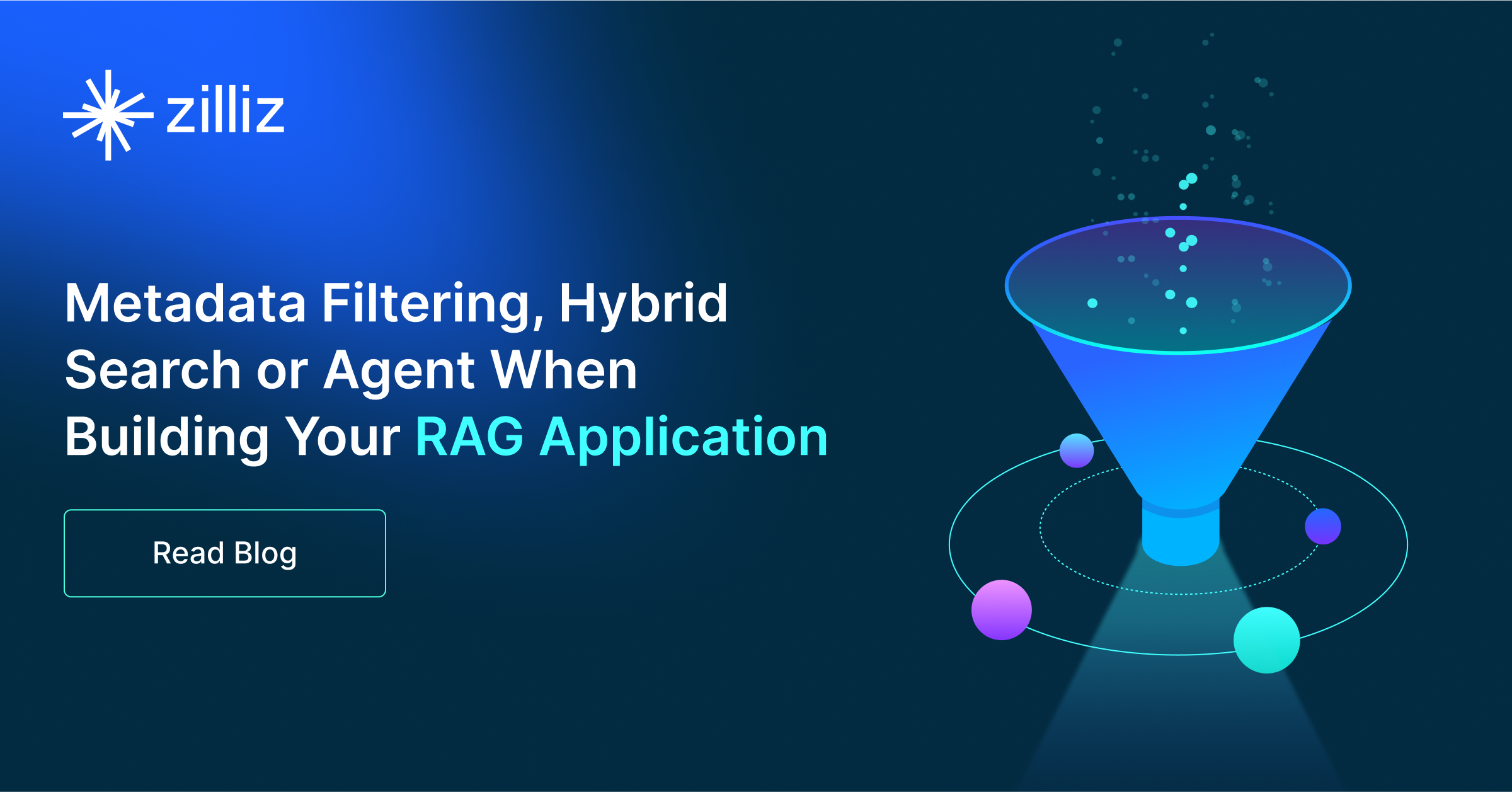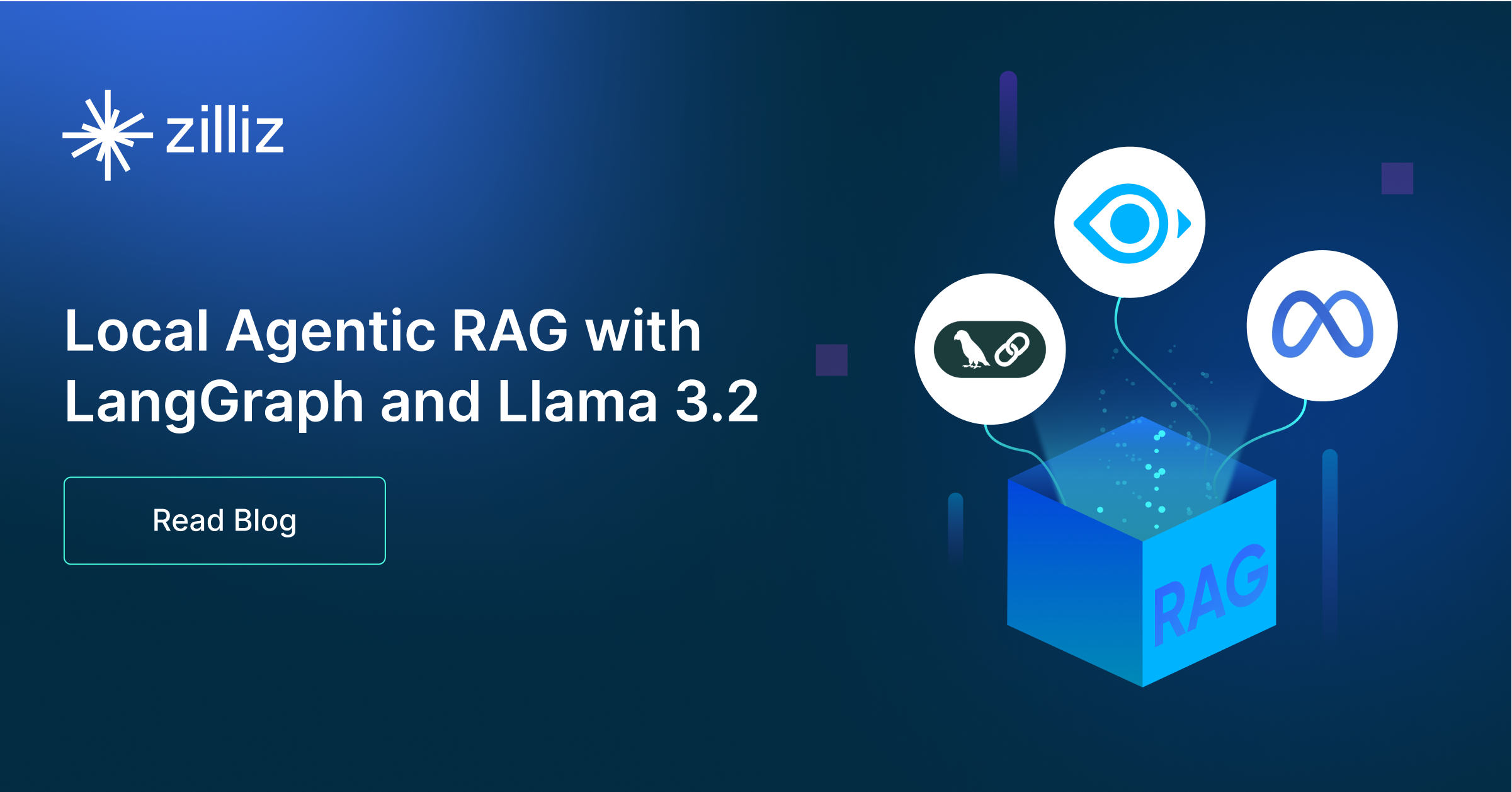Build RAG Chatbot with Haystack, Zilliz Cloud, Mistral Ministral 8B, and jina-embeddings-v3
Introduction to RAG
Retrieval-Augmented Generation (RAG) is a game-changer for GenAI applications, especially in conversational AI. It combines the power of pre-trained large language models (LLMs) like OpenAI’s GPT with external knowledge sources stored in vector databases such as Milvus and Zilliz Cloud, allowing for more accurate, contextually relevant, and up-to-date response generation. A RAG pipeline usually consists of four basic components: a vector database, an embedding model, an LLM, and a framework.
Key Components We'll Use for This RAG Chatbot
This tutorial shows you how to build a simple RAG chatbot in Python using the following components:
- Haystack: An open-source Python framework designed for building production-ready NLP applications, particularly question answering and semantic search systems. Haystack excels at retrieving information from large document collections through its modular architecture that combines retrieval and reader components. Ideal for developers creating search applications, chatbots, and knowledge management systems that require efficient document processing and accurate information extraction from unstructured text.
- Zilliz Cloud: a fully managed vector database-as-a-service platform built on top of the open-source Milvus, designed to handle high-performance vector data processing at scale. It enables organizations to efficiently store, search, and analyze large volumes of unstructured data, such as text, images, or audio, by leveraging advanced vector search technology. It offers a free tier supporting up to 1 million vectors.
- Mistral Ministral 8B: A compact, high-efficiency language model optimized for scalable natural language processing. It excels in rapid text generation, multilingual tasks, and context-aware reasoning while maintaining low computational demands. Ideal for real-time chatbots, content summarization, and edge-device deployment where speed and resource efficiency are critical.
- Jina-Embeddings-v3: A state-of-the-art embedding model designed for high-dimensional vector representations of text, excelling in multilingual understanding and long-context retention. Its scalable architecture ensures robust performance in semantic search, clustering, and retrieval-augmented generation (RAG) systems. Ideal for applications requiring precise semantic analysis across diverse languages and lengthy documents, combining accuracy with efficiency.
By the end of this tutorial, you’ll have a functional chatbot capable of answering questions based on a custom knowledge base.
Note: Since we may use proprietary models in our tutorials, make sure you have the required API key beforehand.
Step 1: Install and Set Up Haystack
import os
import requests
from haystack import Pipeline
from haystack.components.converters import MarkdownToDocument
from haystack.components.preprocessors import DocumentSplitter
from haystack.components.writers import DocumentWriter
Step 2: Install and Set Up Mistral Ministral 8B
To use Mistral models, you need first to get a Mistral API key. You can write this key in:
- The
api_keyinit parameter using Secret API - The
MISTRAL_API_KEYenvironment variable (recommended)
Now, after you get the API key, let's install the Install the mistral-haystack package.
pip install mistral-haystack
from haystack_integrations.components.generators.mistral import MistralChatGenerator
from haystack.components.generators.utils import print_streaming_chunk
from haystack.dataclasses import ChatMessage
from haystack.utils import Secret
generator = MistralChatGenerator(api_key=Secret.from_env_var("MISTRAL_API_KEY"), streaming_callback=print_streaming_chunk, model='ministral-8b-latest')
Step 3: Install and Set Up jina-embeddings-v3
pip install jina-haystack
from haystack_integrations.components.embedders.jina import JinaTextEmbedder
from haystack_integrations.components.embedders.jina import JinaDocumentEmbedder
text_embedder = JinaTextEmbedder(api_key=Secret.from_token("<your-api-key>"), model="jina-embeddings-v3")
document_embedder = JinaDocumentEmbedder(api_key=Secret.from_token("<your-api-key>"), model="jina-embeddings-v3")
Step 4: Install and Set Up Zilliz Cloud
pip install --upgrade pymilvus milvus-haystack
from milvus_haystack import MilvusDocumentStore
from milvus_haystack.milvus_embedding_retriever import MilvusEmbeddingRetriever
document_store = MilvusDocumentStore(connection_args={"uri": ZILLIZ_CLOUD_URI, "token": ZILLIZ_CLOUD_TOKEN}, drop_old=True,)
retriever = MilvusEmbeddingRetriever(document_store=document_store, top_k=3)
Step 5: Build a RAG Chatbot
Now that you’ve set up all components, let’s start to build a simple chatbot. We’ll use the Milvus introduction doc as a private knowledge base. You can replace it your own dataset to customize your RAG chatbot.
url = 'https://raw.githubusercontent.com/milvus-io/milvus-docs/refs/heads/v2.5.x/site/en/about/overview.md'
example_file = 'example_file.md'
response = requests.get(url)
with open(example_file, 'wb') as f:
f.write(response.content)
file_paths = [example_file] # You can replace it with your own file paths.
indexing_pipeline = Pipeline()
indexing_pipeline.add_component("converter", MarkdownToDocument())
indexing_pipeline.add_component("splitter", DocumentSplitter(split_by="sentence", split_length=2))
indexing_pipeline.add_component("embedder", document_embedder)
indexing_pipeline.add_component("writer", DocumentWriter(document_store))
indexing_pipeline.connect("converter", "splitter")
indexing_pipeline.connect("splitter", "embedder")
indexing_pipeline.connect("embedder", "writer")
indexing_pipeline.run({"converter": {"sources": file_paths}})
# print("Number of documents:", document_store.count_documents())
question = "What is Milvus?" # You can replace it with your own question.
retrieval_pipeline = Pipeline()
retrieval_pipeline.add_component("embedder", text_embedder)
retrieval_pipeline.add_component("retriever", retriever)
retrieval_pipeline.connect("embedder", "retriever")
retrieval_results = retrieval_pipeline.run({"embedder": {"text": question}})
# for doc in retrieval_results["retriever"]["documents"]:
# print(doc.content)
# print("-" * 10)
from haystack.utils import Secret
from haystack.components.builders import PromptBuilder
retriever = MilvusEmbeddingRetriever(document_store=document_store, top_k=3)
text_embedder = JinaTextEmbedder(api_key=Secret.from_token("<your-api-key>"), model="jina-embeddings-v3")
prompt_template = """Answer the following query based on the provided context. If the context does
not include an answer, reply with 'I don't know'.\n
Query: {{query}}
Documents:
{% for doc in documents %}
{{ doc.content }}
{% endfor %}
Answer:
"""
rag_pipeline = Pipeline()
rag_pipeline.add_component("text_embedder", text_embedder)
rag_pipeline.add_component("retriever", retriever)
rag_pipeline.add_component("prompt_builder", PromptBuilder(template=prompt_template))
rag_pipeline.add_component("generator", generator)
rag_pipeline.connect("text_embedder.embedding", "retriever.query_embedding")
rag_pipeline.connect("retriever.documents", "prompt_builder.documents")
rag_pipeline.connect("prompt_builder", "generator")
results = rag_pipeline.run({"text_embedder": {"text": question}, "prompt_builder": {"query": question},})
print('RAG answer:\n', results["generator"]["replies"][0])
Optimization Tips
As you build your RAG system, optimization is key to ensuring peak performance and efficiency. While setting up the components is an essential first step, fine-tuning each one will help you create a solution that works even better and scales seamlessly. In this section, we’ll share some practical tips for optimizing all these components, giving you the edge to build smarter, faster, and more responsive RAG applications.
Haystack optimization tips
To optimize Haystack in a RAG setup, ensure you use an efficient retriever like FAISS or Milvus for scalable and fast similarity searches. Fine-tune your document store settings, such as indexing strategies and storage backends, to balance speed and accuracy. Use batch processing for embedding generation to reduce latency and optimize API calls. Leverage Haystack's pipeline caching to avoid redundant computations, especially for frequently queried documents. Tune your reader model by selecting a lightweight yet accurate transformer-based model like DistilBERT to speed up response times. Implement query rewriting or filtering techniques to enhance retrieval quality, ensuring the most relevant documents are retrieved for generation. Finally, monitor system performance with Haystack’s built-in evaluation tools to iteratively refine your setup based on real-world query performance.
Zilliz Cloud optimization tips
Optimizing Zilliz Cloud for a RAG system involves efficient index selection, query tuning, and resource management. Use Hierarchical Navigable Small World (HNSW) indexing for high-speed, approximate nearest neighbor search while balancing recall and efficiency. Fine-tune ef_construction and M parameters based on your dataset size and query workload to optimize search accuracy and latency. Enable dynamic scaling to handle fluctuating workloads efficiently, ensuring smooth performance under varying query loads. Implement data partitioning to improve retrieval speed by grouping related data, reducing unnecessary comparisons. Regularly update and optimize embeddings to keep results relevant, particularly when dealing with evolving datasets. Use hybrid search techniques, such as combining vector and keyword search, to improve response quality. Monitor system metrics in Zilliz Cloud’s dashboard and adjust configurations accordingly to maintain low-latency, high-throughput performance.
Mistral Ministral 8B optimization tips
To optimize Mistral Ministral 8B in RAG setups, ensure input prompts are tightly formatted with clear context-question separation using [INST] tags. Use smaller retrieval chunks (256-512 tokens) to reduce noise and improve relevance. Adjust the temperature (0.1-0.3) for deterministic, fact-focused outputs. Employ a hybrid retrieval approach (dense + sparse methods) to balance precision and recall. Prune retrieved documents with cross-encoder re-rankers before feeding to the model. Limit input context length to avoid truncation, and fine-tune the model on domain-specific data for better alignment. Enable flash attention and quantization (e.g., 4-bit) to reduce latency and memory usage.
Jina-embeddings-v3 optimization tips
To optimize Jina-embeddings-v3 in a RAG setup, preprocess input text by normalizing casing, removing redundant whitespace, and truncating to the model’s maximum sequence length (e.g., 8,192 tokens). Batch embedding generation for parallel processing, balancing GPU/CPU memory constraints. Use FP16 precision for faster inference if hardware supports it. Cache frequently accessed document embeddings to reduce recomputation. Experiment with dimensionality reduction (e.g., PCA) if downstream tasks tolerate lower-dimensional vectors. Regularly update to the latest model version for performance improvements. Monitor latency and adjust batch sizes dynamically for throughput-latency trade-offs.
By implementing these tips across your components, you'll be able to enhance the performance and functionality of your RAG system, ensuring it’s optimized for both speed and accuracy. Keep testing, iterating, and refining your setup to stay ahead in the ever-evolving world of AI development.
RAG Cost Calculator: A Free Tool to Calculate Your Cost in Seconds
Estimating the cost of a Retrieval-Augmented Generation (RAG) pipeline involves analyzing expenses across vector storage, compute resources, and API usage. Key cost drivers include vector database queries, embedding generation, and LLM inference.
RAG Cost Calculator is a free tool that quickly estimates the cost of building a RAG pipeline, including chunking, embedding, vector storage/search, and LLM generation. It also helps you identify cost-saving opportunities and achieve up to 10x cost reduction on vector databases with the serverless option.
 Calculate your RAG cost
Calculate your RAG cost
What Have You Learned?
By diving into this tutorial, you’ve unlocked the power of building a RAG system from the ground up using cutting-edge tools! You learned how Haystack serves as the flexible framework orchestrating your pipeline, simplifying workflows and connecting components seamlessly. Zilliz Cloud stepped in as your high-performance vector database, handling complex similarity searches at scale to retrieve the most relevant context. Then, Mistral Ministral 8B showcased its prowess as a lean yet powerful LLM, generating human-like responses by synthesizing retrieved data with precision. And let’s not forget jina-embeddings-v3, which transformed raw text into rich, semantic vectors, ensuring your system understands nuances and context deeply. Together, these tools form a dynamic RAG pipeline that’s both efficient and adaptable—perfect for chatbots, research assistants, or any application requiring intelligent data interaction.
But it’s not just about the basics! You also explored optimization strategies like fine-tuning chunking strategies and leveraging metadata for faster retrieval. Plus, the tutorial’s free RAG cost calculator gave you a practical way to estimate expenses and optimize resource usage. Now that you’ve seen how these pieces fit together—and how they supercharge each other—it’s time to take the reins! Experiment with different models, tweak parameters for your use case, and let your creativity flow. Whether you’re enhancing customer support, building a knowledge hub, or prototyping the next big AI tool, you’ve got the skills to make it happen. The future of intelligent applications is in your hands—go build something amazing! 🚀
Further Resources
🌟 In addition to this RAG tutorial, unleash your full potential with these incredible resources to level up your RAG skills.
- How to Build a Multimodal RAG | Documentation
- How to Enhance the Performance of Your RAG Pipeline
- Graph RAG with Milvus | Documentation
- How to Evaluate RAG Applications - Zilliz Learn
- Generative AI Resource Hub | Zilliz
We'd Love to Hear What You Think!
We’d love to hear your thoughts! 🌟 Leave your questions or comments below or join our vibrant Milvus Discord community to share your experiences, ask questions, or connect with thousands of AI enthusiasts. Your journey matters to us!
If you like this tutorial, show your support by giving our Milvus GitHub repo a star ⭐—it means the world to us and inspires us to keep creating! 💖
- Introduction to RAG
- Key Components We'll Use for This RAG Chatbot
- Step 1: Install and Set Up Haystack
- Step 2: Install and Set Up Mistral Ministral 8B
- Step 3: Install and Set Up jina-embeddings-v3
- Step 4: Install and Set Up Zilliz Cloud
- Step 5: Build a RAG Chatbot
- Optimization Tips
- RAG Cost Calculator: A Free Tool to Calculate Your Cost in Seconds
- What Have You Learned?
- Further Resources
- We'd Love to Hear What You Think!
Content
Vector Database at Scale
Zilliz Cloud is a fully-managed vector database built for scale, perfect for your RAG apps.
Try Zilliz Cloud for Free


